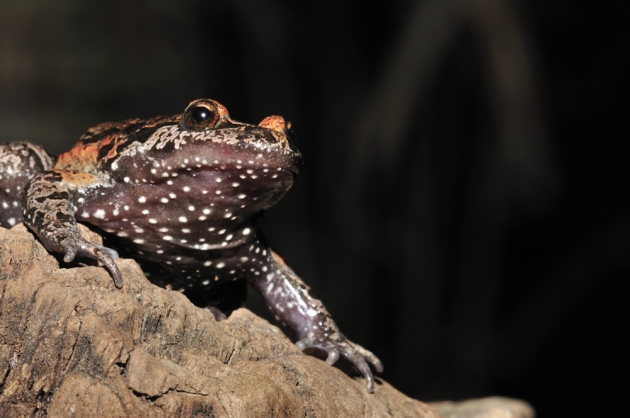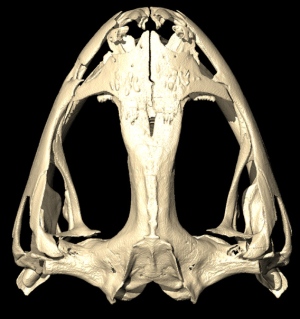The story started with a dead frog. This was no ordinary dead frog, however – it was a preserved specimen of the first species of amphibian ever to have been declared extinct by the International Union for Conservation of Nature (IUCN), back in 1996. After four decades of searching for the Hula painted frog – whose home range had been limited to the boggy Hula Valley of northern Israel – researchers decided the polka-dotted frog had probably been a victim of habitat loss from Israel’s extensive swamp-draining activities in the early to mid-20th century.
In the meantime, Dr. Sarig Gafny of the Ruppin Academic Center at Michmoret and Yoram Malka, a park ranger for the Israel Nature and Parks Authority, had refused to believe reports of the Hula painted frog’s demise, and had continued to search for it. In 2011, they found their first living specimen of the supposedly extinct frog, and several more soon followed. A few of the frogs that had died a natural death more recently than the 1950s gave Biton, Brumfeld and their co-workers in Israel, France and Germany additional samples to complete analyzing the morphology of the frog’s skeleton, as well as to investigate the frog’s DNA.
The researchers were in for a surprise: In examining the structure of the Hula painted frog skeletons – especially the structure of the head – along with the DNA, they realized that the frog had been wrongly classified when it was first observed by investigators in the 1940s. In fact, the frog is more closely related to fossil amphibians than to any living species. Rather than belonging to the genus of painted frogs
Discoglossus, which includes species ranging from Spain to Morocco, it was the sole surviving member of another genus known as
Latonia. Its last relatives in the Latonia genus died out around 15,000 years ago.
These findings appeared in
Nature Communications.
Since the Hula painted frog was declared extinct, dozens of amphibian species have officially gone extinct and hundreds more are endangered or feared to be extinct. Thus the discovery and identification of the Hula painted frog made it an instant icon – a symbol of hope in the face of the generally bleak outlook for many amphibians around the planet. Not only had it seemingly come back from extinction, but the Hula painted frog turned out to be a true living fossil.
Seeing skeletons
The X-ray microtomography machine in Dr. Vlad Brumfeld’s lab is state-of-the-art, enabling researchers to obtain detailed 3-D images of everything from animal skeletons to microscopic bacteria. The improvement over older models, says Brumfeld, lies in the addition of extra scintillators used to convert X-rays into visual information. These enable scientists to image a range of samples, each at the desired resolution. Recording images while rotating the sample in the chamber of the machine makes it possible to produce 3-D images of thick, opaque objects, thus revealing tiny details – down to just a few microns – not seen through other methods.
To obtain the detailed, 3-D image of the Hula painted frog skeleton, Brumfeld used a technique he had developed together with Gili Naveh, a research student in the group of Prof. Stephen Weiner of the Structural Biology Department. During long exposure to the X-rays inside the machinery, such delicate samples as biological specimens are generally submerged in liquid (usually ethanol or water), but such immersion significantly reduces the quality of the images. Naveh and Brumfeld developed a method of saturating the air surrounding the sample with vapor, thus preserving the specimens’ structure while leaving a clear path for the X-rays to penetrate.
The microtomography instrument in Brumfeld’s lab has been used by Institute scientists to reveal, among other things, the internal structure of developing bone, the microstructure of the soft tissue inside teeth, soil infiltration, tiny defects in diamonds, particles of minerals and silica in plant tissue, the shape of micromachinery tools and more.


